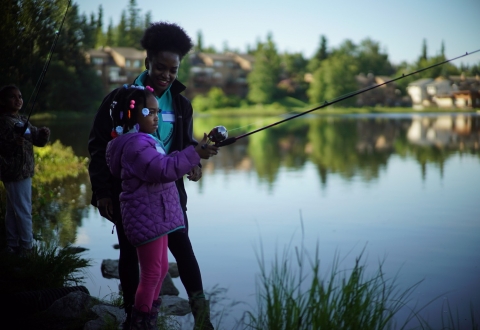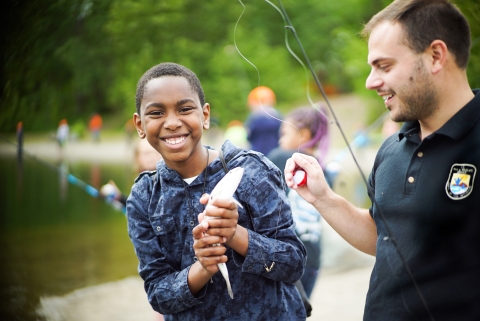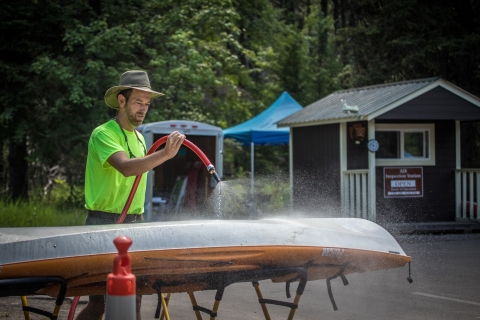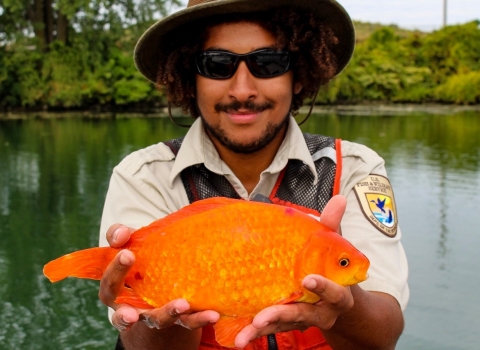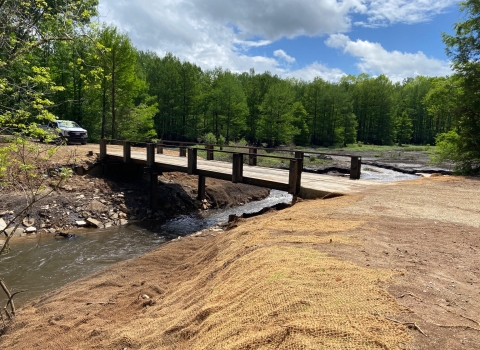National Fishing and Boating Week (June 1 — June 9, 2024) is a great time to learn to fish, reconnect with your kayak, and enjoy the water with friends and family. Whether you've been fishing your whole life, or just picking up a pole for the first time, here are some great ways you can celebrate National Fishing and Boating Week with the U.S. Fish and Wildlife Service!
Take a Friend Fishing at a National Wildlife Refuge or National Fish Hatchery
Fishing is available at 376 national wildlife refuges, 21 national fish hatcheries, and other U.S. Fish and Wildlife Service-managed lands and waters. There is at least one national wildlife refuge national wildlife refuge
A national wildlife refuge is typically a contiguous area of land and water managed by the U.S. Fish and Wildlife Service for the conservation and, where appropriate, restoration of fish, wildlife and plant resources and their habitats for the benefit of present and future generations of Americans.
Learn more about national wildlife refuge or national fish hatchery in each state. Find places to fish with our interactive fishing map or join us for a FREE fishing event near you!
Learn to fish 🎣
You don’t need a ton of gear to start fishing. Check out our beginner’s fishing guide to get started fishing responsibly. The National Fish Hatchery System works with states and Tribes to stock over 100 million sport fish every year to support recreational fishing! Want to try something a little different this year? Try your hand at the growing pastime of microfishing that focuses on the often-overlooked darters, dace, and suckers in our waters.
Protect Our Waters
Fishing can enrich our lives in so many ways — stress relief, improved health, and fun experiences with friends and family. We can help protect fishing for future generations by protecting what we have now! Always carry out what you brought in and never leave behind plastic containers or packaging. Fishing line is very dangerous to birds and other wildlife, so pick up and recycle. To protect the water from invasive species invasive species
An invasive species is any plant or animal that has spread or been introduced into a new area where they are, or could, cause harm to the environment, economy, or human, animal, or plant health. Their unwelcome presence can destroy ecosystems and cost millions of dollars.
Learn more about invasive species , never move fish or plants from one water body to another or release unused live bait into the water.
Clean. Drain. Dry. Dispose
🚿CLEAN off visible aquatic plants, animals, and mud from all equipment before leaving water access — including hulls, interiors, and motors.
💧DRAIN motors, bilge, livewells, and other water containing devices before leaving water access.
🌵DRY everything for five days OR wipe with a towel.
🗑️DISPOSE of unwanted bait, fish parts, and packing materials, in the trash; never dump live fish or other organisms from one water body into another.
Learn more about protecting our waters.
Purchase a fishing license!
Buying a fishing license is quick, easy and directly contributes toward conservation efforts. In most states, licenses can be purchased online, by phone or at retail establishments.
PURCHASE A FISHING LICENSE IN YOUR STATE.
One hundred percent of license fees go directly toward conservation and restoration, but licenses aren’t the only source of conservation funds. For more than half a century, America’s fishing equipment manufacturers have shared a partnership with state and federal biologists through the Dingell-Johnson Act — a partnership that uses excise tax to fund remarkable fisheries conservation and recreation. With these funds state agencies monitor and manage more than 200 species of fish, raise 1 billion fish for stocking annually, and each year provides aquatic education to nearly 1.5 million adults and kids. Since 1952, the U.S. Fish and Wildlife Service’s Sport Fish Restoration Program has distributed more than $11 billion in grants funded through this excise tax paid by manufacturers. Revenue for these grants is generated from manufacturers’ excise taxes on sport fishing equipment, import duties on fishing tackle and pleasure boats, and a portion of the gasoline fuel tax attributable to small engines and motorboats.
Learn more about the fish management, species and habitat restoration, habitat protection, research, education, and public access for fishing and boating supported by manufacturers’ excise taxes. Thank you to all the manufacturers and anglers for supporting conservation and keeping outdoor traditions alive!

